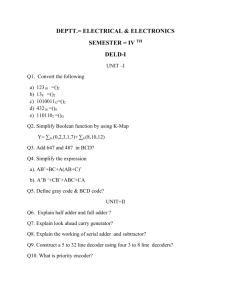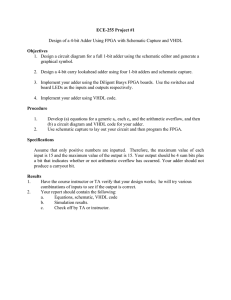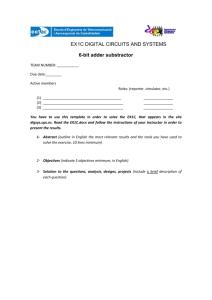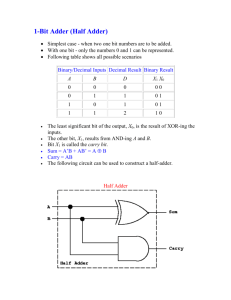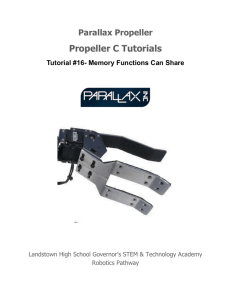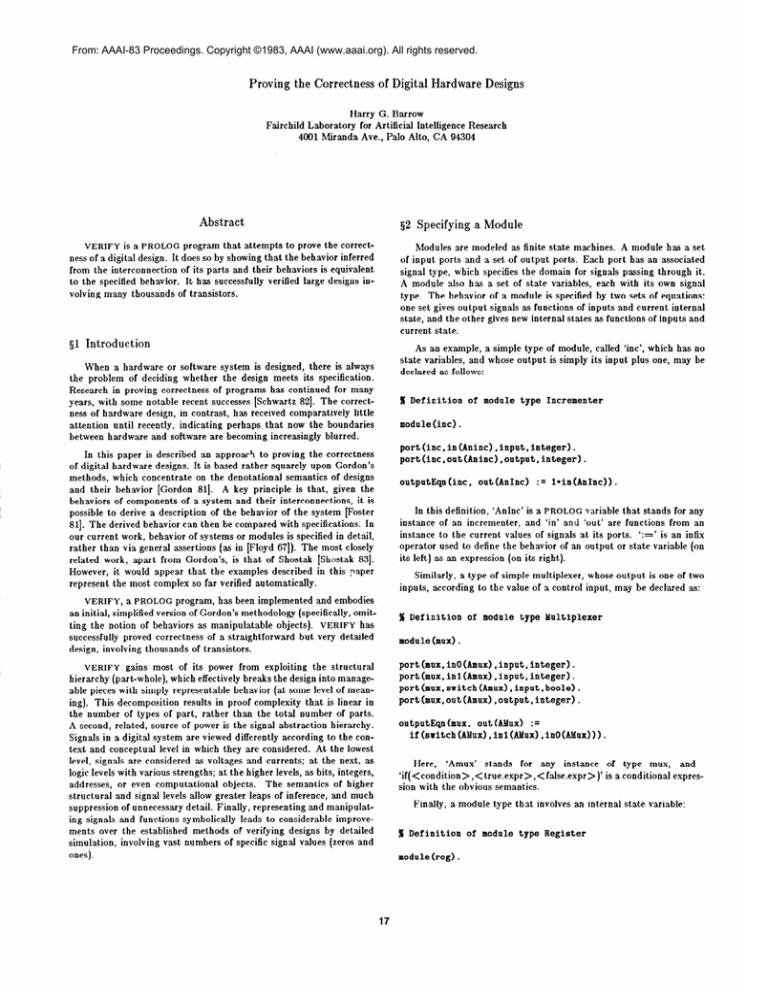
From: AAAI-83 Proceedings. Copyright ©1983, AAAI (www.aaai.org). All rights reserved.
Proving
the Correctness
Fairchild
of Digital
Hardware
Designs
Harry G. Barrow
Laboratory
for Artificial Intelligence Research
4961 Miranda Ave., Palo Alto, CA 94304
Abstract
$2 Specifying
VERIFY
is a PROLOG
program that attempts to prove the correctness of a digital design. It does so by showing that the behavior inferred
from the interconnection
of its parts and their behaviors is equivalent
to the specified behavior. It has successfully verified large designs involving many thousands of transistors.
a Module
Modules are modeled as finite state machines. A module has a set
of input ports and a set of output ports. Each port has an associated
signal type, which specifies the domain for signals passing through it.
A module also has a set of state variables, each with its own signal
type. The behavior of a module is specified by two sets of equations:
one set gives output signals as functions of inputs and current internal
state, and the other gives new internal states as functions of inputs and
current state.
$1 Introduction
As an example, a simple type of module, called ‘inc’, which has no
state variables, and whose output is simply its input plus one, may be
declared as follows:
When a hardware or software system is designed, there is always
the problem of deciding whether the design meets its specification.
Research in proving correctness of programs has continued for many
years, with some notable recent successes [Schwartz 821. The correctness of hardware design, in contrast, has received comparatively
little
attention until recently, indicating perhaps that now the boundaries
between hardware and software are becoming increasingly blurred.
I Definition
of module
module (inc)
type
Incrementer
.
port (inc, in (Aninc) input,integer).
port (inc, out (Aninc 1 , output, integer)
In this paper is described an approach to proving the correctness
of digital hardware designs. It is based rather squarely upon Gordon’s
methods, which concentrate
on the denotational
semantics of designs
and their behavior [Gordon 811. A key principle is that, given the
behaviors of components of a system and their interconnections,
it is
possible to derive a description of the behavior of the system [Foster
811. The derived behavior can then be compared with specifications. In
our current work, behavior of systems or modules is specified in detail,
rather than via general assertions (as in [Floyd 671). The most closely
related work, apart from Gordon’s, is that of Shostak [Shostak 831.
However, it would appear that the examples described in this paper
represent the most complex so far verified automatically.
outputEqn
(inc,
out (AnInc)
.
:= l+in(AnInc))
.
In this definition, ‘AnInc’ is a PROLOG
variable that stands for any
instance of an incrementer,
and ‘in’ and ‘out’ are functions from an
instance to the current values of signals at its ports. ‘:=’ is an infix
operator used to define the behavior of an output or state variable (on
its left) as an expression (on its right).
Similarly, a type of simple multiplexer, whose output is one of two
inputs, according to the value of a control input, may be declared as:
VERIFY,
a PROLOG
program, has been implemented and embodies
an initial, simplified version of Gordon’s methodology (specifically, omitting the notion of behaviors as manipulatable
objects). VERIFY
has
successfully proved correctness of a straightforward
but very detailed
design, involving thousands of transistors.
% Definition
of module
type
Multiplexer
module (mux) .
port
port
port
port
VERIFY
gains most of its power from exploiting the structural
hierarchy (part-whole), which effectively breaks the design into manageable pieces with simply representable behavior (at some level of meaning). This decomposition
results in proof complexity that is linear in
the number of types of part, rather than the total number of parts.
A second, related, source of power is the signal abstraction
hierarchy.
Signals in a digital system are viewed differently according to the context and conceptual level in which they are considered. At the lowest
level, signals are considered as voltages and currents; at the next, as
logic levels with various strengths; at the higher levels, as bits, integers,
addresses, or even computational
objects.
The semantics of higher
structural
and signal levels allow greater leaps of inference, and much
suppression of unnecessary detail. Finally, representing and manipulating signals and functions symbolically leads to considerable improvements over the established methods of verifying designs by detailed
simulation, involving vast numbers of specific signal values (zeros and
ones).
(mux,
(mux,
(mux,
(mux,
inO(Amux) ,input. integer).
in1 (Amux) , input, integer).
switch (Amux), input, boole)
out (Amux) , output, integer)
.
.
outputEqn (mux, out (AMux) :=
if (switch (A&ix), in1 @MUX), in0 (Mbux) 1
Here, ‘Amux’ stands
for any instance
‘if(<condition>
,<true.expr>,<false.expr>)’
sion with the obvious semantics.
Finally,
a module type that involves an internal
% Definition
module (reg) .
17
of type mux, and
is a conditional expres-
of module
type
Register
state variable:
muxA(Acomeer)
regA (Acounter)
incA(Aconnter)
part (counter,
part (counter,
part (counter,
I
reg
count
I
connected
connected
connected
connected
connected
connected
(counter,
(counter,
(counter,
(counter,
(counter,
(counter,
,mx) I
, reg) .
, inc) .
ctrl (Acounter),
switch (muxA(Acounter))
>.
in (Acounter) ,inl (auxA(Acounter)))
.
out (muxA(Acounter)) , in(regA (Acounter) 1) .
out (regA(Acounter)) , in (incA (Acounter) 1) .
out (incA(Acounter))
, in0 (muxA(Acounter))>
out (regA (Acounter) 1, out (Acounter))
.
contents
z!i
contents:=in.
g Behavior
specification:
out:=contents.
state
out
I
(counter,
count (Acounter) , integer) .
count (Acounter) .contente
StateMap (counter,
outputEqn
(counter,
out (Acounter)
(regA(Acounter))
)
:= count (Acounter)).
StateEqn (counter,
count (Acounter)
:=
if (ctrl (Acounter),
in (Acounter), count (Acounter) +l)) .
count:=if(ctrl,in,count+l).
out:=count.
I out
Figure
1. A loadable
counter.
The state variable, ‘count(Acounter)‘,
declared in the behavior specification above is for the purpose of describing the counter as a black
box. It actually corresponds
to the state variable of the register,
‘contents(regA(Acounter))‘,
and the renaming is accomplished by the
‘StateMap’ declaration.
.
port (reg. in (Areg) , input, integer)
.
port (reg, out (Areg) , output, integer)
ntate(reg,contents
(Areg) , integer).
The description
language
structs: constants, parameters,
nections.
(ABeg) 1.
outputEqn (reg pout (ABeg) : = contents
stateEqn (reg. contents
(ABeg) := in(ABeg)).
supports several additional useful conpart and port arrays, and bit-wise con-
Constants can be declared in a similar manner to state variables,
specifying their name and type, and also their value. Connections can
then be specified from the constants to input ports of parts.
This
approach has the advantage that constants are prominently visible in
a description, and their values are not embedded in expressions, which
makes editing much more reliable.
Parameters may be provided to module declarations, so that a single
description may cover several distinct types of module. For example,
one parameter might indicate the width of inputs and outputs in bits,
while another might be the value of a hard-wired constant.
Arrays of parts, ports, state variables, and constants are easily represented, adding a subscript to the arguments of selector functions. For
example ‘in(AModule,I)’ refers to the Ith ‘in’ port of module ‘AModule’.
We can, for example,
as follows:
% Definition
specify a loadable counter,
of module
type
Bit-wise connections are specified by use of a function ‘bit’, as in
‘bit(I,x)‘, which represents the selection of the Ith bit of a signal, 'X'.
shown in Figure 1,
Parameters, constants, arrays, and bit-wise connections can be best
understood by considering an example. In the following, an ‘adder’ is
constructed from a collection of ‘fullAdder’s, each of which has inputs
‘inx’, ‘iny’, and &cin’(the carry in), and outputs ‘sum’ and ‘carry’.
Counter
module (counter).
port (counter,
in (Acounter) , input, integer) .
port (counter,
ctrl (Acounter) , input, boole) .
port(counter,out(Acounter),output,integer).
# Definition
of an (B+l)-bit
module (adder(B) 1.
18
adder in terma
of fullAdders
In constructing
the Functionai expressions Bar outputs, B (pertain
amount of checking is performed.
It is possible to check tha6 no line
is driven by two outputs simultaneously
(unless they are tri-state outputs), that every line has an output and an input, and that every output and state variable is accounted for. The signal types of connected
outputs and inputs are checked for compatibility
in the signal abstraction hierarchy, and an appropriate
type conversion is made where appropriate, or the user warned where it is not. A special form of ‘typeconversion’ occurs when bit-wise connections are made: integer outputs
can be embedded in bit-selection functions, and bit inputs can be collected into integers as terms in a power series.
(H) ‘B.
port (adder(M) , inx(Adder)
, input I integer
.
port (adder (II), iny(Adder)
, input, integer(H))
port (adder (1) ,out (Adder), output,
integer
(El) )
.-- 181 is ll+l.
constant
(adder(g)
, carryin
part(adder(l)
,fa(Adder,I)
:- range(O,I,I).
connected
(adder
(Adder)
,0, boole)
,fullAdder)
(B) , bit (I, inx(Adder))
.
% an array
, inx(f
of parts
a (Adder,
I) ))
*- range(O,I,IU.
connkted(adder(l)
,bit(I,iny(Adder))
In principle, the given behavior specification for a module also should
be checked for errors. A simple type-check on the arguments of subexpressions could be easily performed, but in practice, this has not yet
been implemented.
,iny(fa(Adder,I)))
:- range(0,I.B).
connected(adder(l)
,carryin(Adder)
,cin(fa(Adder,O)))
.
connected(adder(B),carry(fa(Adder,I)),cin(fa(Adder,Il)))
*- range(l.11.P).
I is 11-l.
connected(adder(P),sum(fa(Adder,I)),bit(I,out(Adder)))
:- range(0,
I,g>.
connected
(adder(B)
,carry(fa(Adder,B)),
bit (Bl,out(Adder)))
:- El1 is I+l.
# Behavior
outputEqn
The behavior descriptions
(whether given in the specification,
or
constructed
from the structure) are useful for many purposes. Values
can be supplied for input signals and state variables, and output values
can be determined
by the evaluation and simplification
mechanism
described later.
It is not necessary to supply literal values for all
variables: values can be left as variables. Thus we can simplify output
expressions for such purposes as optimization, or specialization.
We can
also perform symbolic simulation, propagating
symbols for variables
which have definite, but unknown, values. For example, by symbolic
simulation we can show that in the multiplexer primitive defined above,
when ‘switch’ is true, the output is ‘inl’, regardless of the actual value
of ‘inl’. This approach has the potential for much faster checking
of a design by simulation than instantiating
values for all variables,
as is currently done. In this work, however, the major purpose of
constructing
behavior descriptions
is so that they may be compared
with the specified behavior and the design verified.
specification:
(adder (8) ,out (Adder)
:= inxcbdder)
+iny(Adder))
.
In this example, ‘N’ is a parameter specifying the number of bits
in the inputs to the adder (i.e. the most significant bit represents
2“‘). The adder is composed of N+l ‘fullAdder’s, specified in the
‘part’ declaration,
and the construct ‘range(O,I,N)’ means simply that
‘I’may take any value from ‘0’ to ‘N’. Individual bits of the inputs are
connected to the ‘fullAdder’s, and their outputs are bit-wise-connected
to the adder output. The equation describing the behavior of the adder
is the specification, and is concerned only with input/output
behavior,
not reflecting any of the internal structure.
$4 Verifying
To facilitate subsequent computations,
module descriptions are converted from the “human-convenient”,
parametrized notation above into
a more explicit form. For example, the adder description might be converted into descriptions of 3- and 5bit adders, if these were required
in the course of verification.
The conversion is only done once, when
needed, and the results are cached.
$3 Inferring
Behavior
the design of a module
When presented with a module to be verified, the system recursively
verifies each of its parts, constructing
a behavior description from its
structure, and comparing it with the specified behavior. The behaviors
are compared by considering the outputs, and state variables, in turn.
Each output has two expressions that purport to describe its functional
behavior. These are equated and an attempt is made to prove that the
equation is an identity (i.e. holds for all possible values of inputs and
states). The module is correct if this can be done for all outputs and
state variables.
from Structure
In work on verification, Shostak has developed a decision procedure
for quantifier-free Presburger arithmetic (no multiplication,
except by
constants) extended to include uninterpreted
functions and predicates
[Shostak 791. S UCh a d ecision procedure seems to be applicable in many
cases of program verification, and could be a useful component of our
design verification system, but has not been implemented.
Given the behavior of its parts, and their interconnections,
it is
possible to infer the behavior of a composite module. For each of its
output ports, we can trace back a connection to an output port of some
part. That port has an equation describing its output as a function of
the inputs (and state) of the part. The inputs can themselves be traced
back to outputs of other parts, or to an input of the module, and so
on. The state variables of parts are replaced by the equivalent state
variables of the module. Thus we can construct an expression that
describes the module output as a function of the module inputs and
state variables (similar to the specification).
The current strategy for determining
whether an equation is an
identity involves a sequence of steps. First, the equation is checked
to see whether it is a trivial identity, of the form ‘X=X’ or ‘true’, or
whether it is a trivial non-identity, such as ‘a=b’, where ‘a’ and ‘b’ are
constants.
This back-tracing
process runs into trouble if there are loops in the
interconnection
of parts, but only if the loops are not broken by a state
variable, as in the counter described above. For such cases, we need
to introduce new state variables, but this is not done in the current
implementation.
(See [Shostak 831 for another approach to designs with
loops.) Loops do not in practice seem to cause many problems: the
Mead-Conway
design methodology
advocates breaking all loops with
clocked dynamic storage elements, thereby conveniently providing the
required state variables [Mead and Conway SO].
If the equation is not trivial, the size of the domain space of the
equation is then determined by finding the cardinality of the domains
of the input and state variables occurring in it. If the space size is
sufficiently small (less than about 40 combinations of variable values),
the equation is tested by enumeration:
each combination
of variable
values is generated and substituted
into the equation, which is then
simplified to ‘true’ or ‘false’. This “brute-force” approach is surprisingly useful. Complex designs are usually composed of many simple
pieces that are amenable to proof by enumeration, but which would re-
19
quire much additional mathematical
tion to prove by other means.
knowledge and alglbrair
The most ambitious example that. has been attempt+,1 is the modgrle
known as D74, decomposed in Figure 2. The example was taken from
Genesereth [Genesereth 821, which addresses the problem of fault diagnosis. However, our version is enormously more detailed. D74 contains,
at the top level, three multipliers and two adders. The multipliers are
composed of slices, each of which contains a multiplexer, a shifter, and
an adder. The adders are built from full-adders, which are built from
selectors, which are built from logic gates. The logic gates are themselves described at two levels: an abstract boolean function level, and a
level closer to an underlying NMOS
transistor model, involving tri-state
signals and stored charge. Enhancement
and depletion mode transistors, along with joins and ground, are the primitives upon which the
entire design rests. The design specification occupies about 430 lines of
PROLOG
data.
manipula.-
When an equation is too complex for enumeration,
an attempt
is made to prove identity by symbolic manipulation.
This strategy
incorporates
several operations: evaluation, simplification,
expansion,
canonicalization,
and case analysis.
Evaluation involves recursively considering subexpressions, such as
‘1+2’, to see whether they can be replaced by constants, such as ‘3’.
Simplification
is an extension of evaluation that can replace a subexpression by a simpler one. For example, ‘and(true,x)’ is simplified to
‘x’. Evaluation and simplification are implemented by sets of transformation rules that are recursively applied to expressions.
Expansion occurs when a function is observed on one side only of
the equation.
The definition of the function is then substituted
for
its call by another rewriting rule. Bit-wise connection of signals is a
special case: the observation of ‘bit(i,x)’ on one side of the equation can
lead to the expansion of x as a power series of its bits on the other side.
Bit-expansion is used fairly frequently in the examples tried so far.
D74 is parametrized
in the number of bits in its input data. An instance that has three 8-bit inputs involves 50 different types of module,
from 8-bit multipliers, 16bit adders, 15-bit adders, and so on, down
to transistors, with 9 levels of structural
hierarchy.
There are 23,448
primitive parts, including 14,432 transistors.
Verification of this design took 8 minutes and 15 seconds of cpu
time on a DEC 2080 running compiled PROLOG.
Of this time, about 2
minutes is spent in pretty-printing
expressions for monitoring (which
results in about 6000 lines of output).
Canonicalization
attempts to deal with certain combinatorial
problems of representation.
In particular, it handles associativity and commutativity
of functions (such as ‘+‘, ‘x’, ‘and’, and ‘or’) and their
units and zeros. Nested expressions involving an associative function
are flattened, units of the function are discarded, and any occurrence
of a zero of the function causes the expression to be replaced by the
zero. The terms in the lIattened expression are then lexically ordered,
and the nested expression rebuilt. Other normalizations,
such as putting logical expressions into a normal form, or pulling conditional expressions to the outside, are accomplished by the rewrite rules during
simplification.
Slightly larger designs have been verified (over 18000 transistors)
but the current implementation
begins to run out of space at about
this level.
36 Conclusion
Case analysis is performed when the equation involves conditional
expressions, which by this time are outermost in the expression. The
analysis descends recursively through the conditionals,
substituting
truth for the condition in the true-expression,
and falsity for it in the
false-expression.
For example, if the condition is ‘x=1’ then ‘1’ can be
substituted
for ‘x’ in the true-expression,
and ‘false’ for ‘x=1’ in the
does not deal with all
false-expression.
In its present form, VERIFY
the ramifications of the conditional in both branches.
VERIFY
is only a first attempt at implementing a design verification
system that is founded on a clear mathematical
model, and that can
deal with designs of an interesting degree of complexity. The present
version is tuned in a few places to handle some special cases, and much
must be done before it can be made into a real design tool. However,
hints of the potential of this approach, and particularly
the virtues of
structured designs, are already evident.
Work for the immediate future includes trying the system on real
production designs, implementing
the interactive proof checker, and
extending the representations
and methodology to handle conveniently
such modules as memories.
More ambitious examples can then be
tackled.
Evaluation,
simplification,
expansion, canonicalization,
and case
analysis can be applied repeatedly until they no longer have any effect.
(In practice some care has been taken in the implementation
to apply
them in ways that avoid large amounts of wasted effort.) If the resulting
expression is trivial, identity will have been proved or disproved.
If automatic
symbolic manipulation
does not manage to produce
an answer, an interactive mode is entered. It was originally intended
that the interactive mode would be the primary means of proof, with
the user specifying the strategy (collect terms, substitute,
simplify,
etc.) and the system executing the tactics and doing the necessary
bookkeeping.
The interactive facility has not yet been implemented,
partly because surprisingly
much progress has been made using the
automatic strategy described above ! Interaction
is currently limited
to responding to the system’s final, desperate question “Is this an
identity?” with “yesn, “no”, or “unknown”, although development of
an interactive prover is intended in the near future.
References
[Floyd 671 Floyd,
Amer.
R. W.,
Math.
Sot.
“Assigning
Symp.
Meanings
in Applied
Math.,
to Programs,” Proc.
19 (1967) 19-31.
[Foster Sl] Foster, M. J.,
“Syntax-Directed
Verification of Circuit
Function,”
in VLSI Systems
and Computations,
H. Kung, B.
Sproull, and G. Steele (ed.), Computer Science Press, CarnegieMellon University, Pittsburgh,
1981, 203-212.
[Genesereth
Design
821 Genesereth,
M. R.,
“Diagnosis Using Hierarchical
Models,” in Proc.
National
Conference
on Artificial
Intelligence,
AAAI-82, Pittsburgh,
August, 1982.
$5 Results
[Gordon 811 Gordon, M., “Two Papers on Modelling and Verifying
Hardware,”
in Proc. VLSI International
Conference,
Edinburgh,
Scotland, August, 1981.
VERIFY
is composed of about 2400 lines of PROLOG
source code,
resulting in 31000 words of compiled code. It has been tested on a small
number of example cases. VERIFY
can readily handle the example of
the counter given above. During execution, it prints a large quantity
of monitoring information on the terminal, so that the user can watch
its recursive descent through a design.
[Mead and Conway
VLSI Systems,
801 Mead, C., and L. Conway,
Adison-Wesley , Philipines, 1980.
Introduction
to
[Schwartz 821 Schwartz, R. L., and Melliar-Smith,
P. M., “Formal
Specification and Mechanical Verification of SIFT: A Fault-Tolerant
20
d74
inA
c outG
inB
’ out.H
inC
Ilxzwke
inx
sumin
iny
adder
iny
mlx2
inx ctrl
J
iny
carry
sum
in
out
source
in
Figure
2. Structural
decomposition
Flight Control System,” SRI International,
TR CSL-133, January, 1982.
[Shostak 791 Shostak, R. E.,
Arithmetic
with Function
(April, 1979), 351-360.
of
D74.
Six of the modules have variants
Msnlio !%rk CsIifornia
differing in the values of their parameters.
[Shostak 821 Shostak, R. E., Schwartz, R. L., and Melliar-Smith, P. M.,
“STP: A Mechanized Logic for Specification and Verification,” in
Proc.
Sizth Con/.
on Automated
Deduction,
Courant Institute,
New York, June, 1982.
“A Practical Decision Procedure for
Symbols,* Journal of the ACM 26, 2
[Shostak
831 Shostak,
Third
1983.
21
Caltech
R. E.,
Conf.
“Verification of VLSI Designs,” in Proc.
Computer Science Press, March
on VLSI,

